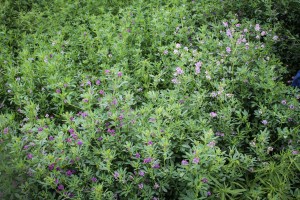Let’s revisit regulated deficit irrigation and the analysis Mike Cohen did last year of the problems and opportunities associated with forage crops in the Colorado River Basin, shall we?
Golf and the Bellagio Fountain are easy targets. But if you’re not talking about alfalfa, you’re not being serious. Here’s Cohen et al.:Irrigated pasture and forage crops, used primarily to feed beef and dairy cattle and horses, cover about two million acres (60 percent) of the irrigated land in the Colorado River basin. In Nevada and in Wyoming, pasture and forage account for almost all irrigated acreage; in Colorado and in Utah, more than 85 percent of irrigated acreage in the basin is in pasture or forage. We estimate that irrigated pasture and forage in the basin consumes more than five million acre-feet of water each year.
That’s more than golf.
But we don’t just go taking things away from people because we think we have a better use for the thing (at least we shouldn’t), and the farmers have reasonable expectations that we won’t just barge in and shut down their irrigation turnouts. In addition, communities have grown around these reasonable expectations. There are real equity issues here, but even if you disagree with that assessment, the reality is that we’re not going to get any sort of traction for Colorado Basin solutions that don’t take into consideration the political interests of the farmers.
What if there were a way to keep all that land in production and still save water? That’s where “deficit irrigation” comes into play as the Western Farm Press reported:
[D]eficit irrigation can be a good option for keeping land in production under dwindling water allocations.
“In some fields growers may be forced to deficit irrigate whether they want to or not,” Munk said. “The question is do we cut land from production or change our irrigation management through things like deficit irrigation?”
Traditional irrigation attempts to maximize the amount of water a crop can use. But when water supplies are constrained, the amount of crop per unit water can be optimized instead. For example, you can reduce alfalfa irrigation during the hottest summer months, when it takes a relatively large amount of water for a relatively smaller yield return. Alfalfa’s an insanely tough plant, plenty drought resistant. Deprive it of water in the hot summer months and it just hunkers down and waits for fall.
When the Central Arizona Project folks earlier this month rang the alarm bells about the problems of a dropping Lake Mead, they suggested we need to find somewhere between 600k and 900k acre feet of water to protect the system from the risk of collapse. Cohen et al. suggest you could get 970k acre feet of water per year by applying regulated deficit irrigation to alfalfa basin wide, or 834kaf by doing it only in the Lower Basin. Pay farmers for the water saved, to compensate them for the reduced yield.


Pingback: Blog round-up: Mega-droughts, water surcharges, weakening enviro protections and lessons learned from the drought, plus the BDCP, water bond, groundwater and more … » MAVEN'S NOTEBOOK | MAVEN'S NOTEBOOK
Pingback: Almonds, water policy and cropping decisions | jfleck at inkstain